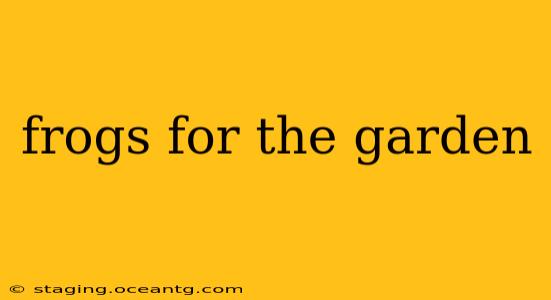Frogs are fascinating creatures, and having them in your garden can be incredibly beneficial. These amphibious friends provide natural pest control, enriching the biodiversity of your outdoor space. But how do you attract frogs to your garden? This comprehensive guide will delve into the best ways to create a frog-friendly haven, addressing common questions and concerns.
Why Attract Frogs to Your Garden?
Before we explore how to attract frogs, let's understand why you'd want them in your garden in the first place. Frogs are voracious eaters, consuming a wide variety of insects, slugs, snails, and other garden pests. This natural pest control can significantly reduce the need for harmful pesticides, leading to a healthier garden and environment. Their presence also contributes to a more balanced ecosystem, adding to the overall biodiversity of your outdoor space.
What Kind of Frogs Live in Gardens?
The type of frog you attract will largely depend on your geographical location and the habitat you create. Common garden frogs vary widely in size, color, and behavior. Researching the native frog species in your area will help you tailor your garden to their specific needs. Some common species often found in gardens include green frogs, tree frogs, and even toads (which are also amphibians!).
What Do Frogs Need to Thrive in a Garden?
Creating a frog-friendly garden involves providing the essential elements these amphibians need to survive and thrive. These include:
Water Source: This is the most crucial element. Frogs need a clean water source for drinking, breeding, and keeping their skin moist. A pond, even a small one, is ideal. A birdbath with shallow sloping sides also works, ensuring frogs can easily enter and exit. Regularly clean and replenish the water to prevent the growth of harmful bacteria.
Shelter: Frogs need places to hide from predators and the sun. This could include rocks, logs, leaf litter, dense vegetation, or even purpose-built frog houses. Providing ample cover makes them feel safe and secure.
Food: While you don't need to actively feed your frogs, ensuring a diverse insect population in your garden will naturally provide a food source. Avoid using pesticides, as these can harm frogs and their prey.
How Can I Attract Frogs to My Garden?
Attracting frogs involves creating a habitat they find appealing. This involves carefully considering the elements mentioned above:
- Build a pond: Even a small, shallow pond can make a big difference.
- Plant native vegetation: Native plants provide shelter and attract insects that frogs feed on.
- Create hiding places: Rocks, logs, and leaf piles offer refuge.
- Avoid pesticides and herbicides: These chemicals can harm frogs and their food sources.
- Keep the area damp: Frogs need a moist environment to thrive.
What Plants Attract Frogs to My Garden?
Many plants are beneficial for attracting frogs, but native plants are particularly important because they support the local ecosystem. These plants often provide cover, attract insects, and help maintain a moist environment. Consult local nurseries or wildlife organizations for recommendations on native plants suitable for your area.
How Long Does it Take to Attract Frogs to My Garden?
The time it takes to attract frogs varies depending on several factors, including the suitability of the habitat and the local frog population. You might see frogs within a few weeks of creating a suitable environment, while others might take longer. Patience is key.
Are Frogs Harmful to My Garden?
No, frogs are generally beneficial to gardens. They help control pest populations, keeping your plants healthy and reducing the need for harmful pesticides. They pose no threat to humans or pets.
What Should I Do If I Find a Frog in My Garden?
If you find a frog in your garden, simply admire it from a distance and leave it undisturbed. Providing a suitable habitat will encourage them to stay. Avoid handling frogs unnecessarily, as this can stress them.
By following these guidelines, you can create a thriving frog habitat in your garden, benefiting both the environment and your plants. Remember, the key is to provide water, shelter, and a healthy environment free from harmful chemicals. Enjoy the beauty and benefits of these fascinating amphibians!
